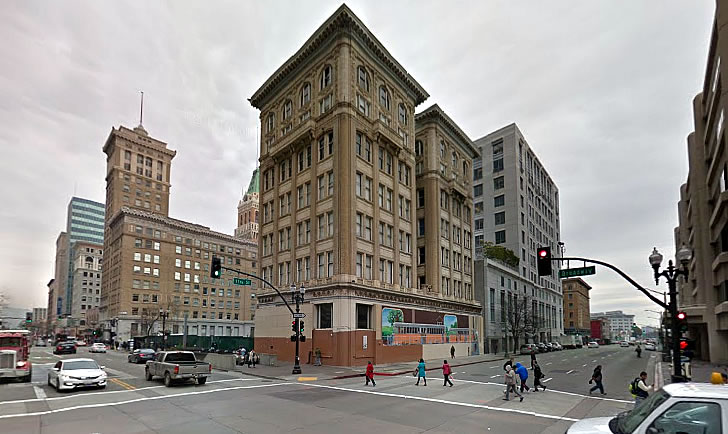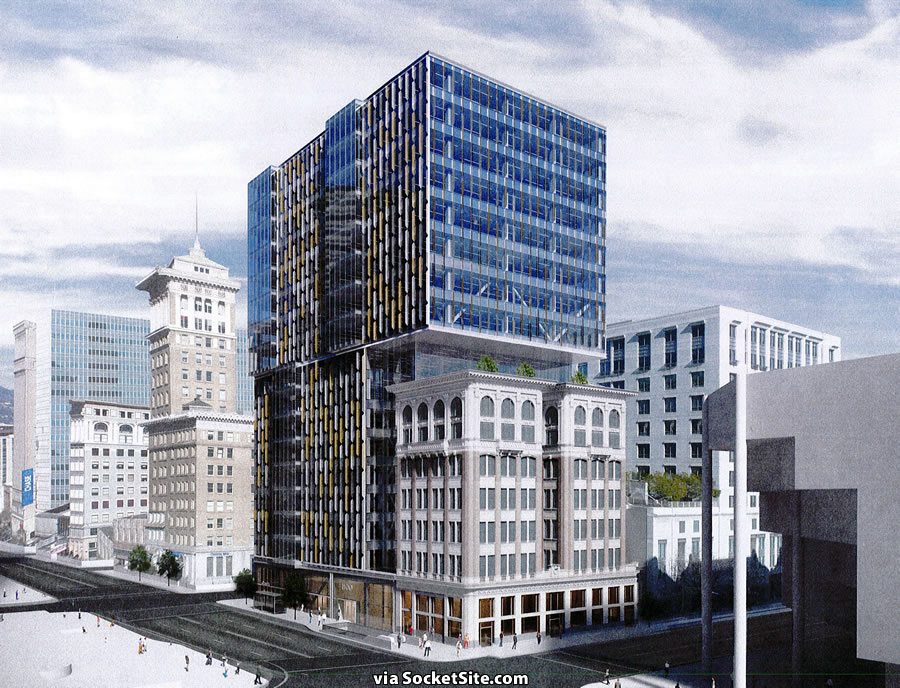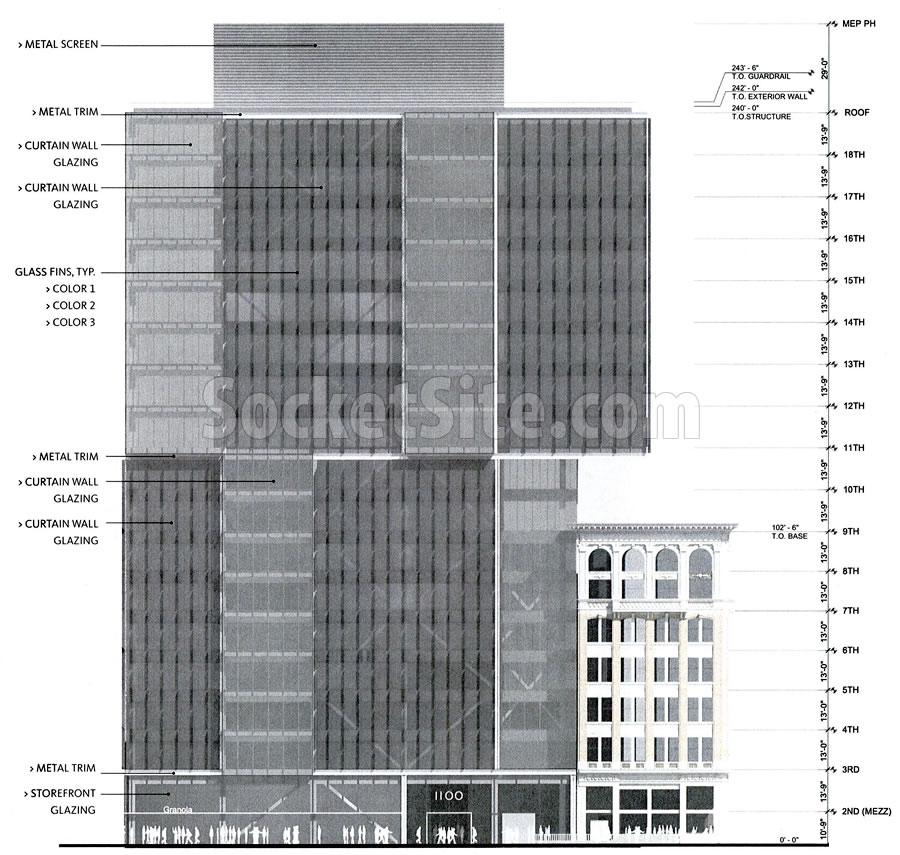Ellis Partners is abandoning the previously approved plans for a 20-story tower to rise at 1100 Broadway in Downtown Oakland. And instead, they’re proposing to develop an 18-story building, the top eight floors of which would be cantilevered over the historic Key System Building on the site.
As designed by Gensler, the cantilevered portion of the tower would extend 25 feet over the historic eight-story building, with roughly 27 vertical feet separating the two.
The dilapidated Key System Building, which was built in 1911 and the former headquarters of the Key System Railway (which ran a line across the lower deck of the Bay Bridge between the East Bay and San Francisco), is slated to be completely renovated and structurally joined to the new building, allowing for continuous floor plates across the entire third to eighth floor of the development.
In total, the 1100 Broadway development is designed to yield 310,000 square feet of office space, roughly a third of which has been pre-leased to the University of California Office of the President, and 10,000 square feet of ground floor retail space fronting Broadway and 11th Street.
And assuming the new approach is approved, Ellis Partners, which purchased the long-dormant project site from SKS Partners in a joint venture with Intercontinental Real Estate Corporation a few months ago, is aiming to break ground by the end of the year and have 1100 Broadway ready for occupancy in late 2019 or early 2020.



Please build this!
I’ve always admired the understated elegance of the Key System Building and thought they would make for wonderful apartments. Still, this is better than the current condition despite the cantilever feeling a bit boorish, i’ll reserve further judgement once I see more.
Agreed that it feels a bit boorish toward the Key Building, like it’s trying to intimidate it.
kinda like trump hulking behind clinton during the debates?
You took the words right out of my mouth!
Looks pretty good to me.
Looks good to me. I always think its cool when there’s a juxtaposition of old and new architecture.
Yes, better than a hole in the ground. I just wish we’d build some 600+ foot buildings in the downtown core. This site would have been perfect as it’s on top of BART and across the street from City Center.
Yes. Metropolitan Transportation Commission should be there, in addition to UCOP. I’m still amazed that they managed to move to a much less transit accessible location in San Francisco. If Libby had been Mayor back then, it never would have happened.
The problem with downtown Oakland is the proximity to the Hayward fault. That, coupled with the soils conditions typically found in the neighborhood, requires a very expensive foundation system and makes anything over 240’or so very difficult to pencil.
This was (already) discussed rather thoroughly. So perhaps you can put your engineering and geologic training to use and explain to us exactly what kind of unique and “very expensive foundation systems” the not very unique soils of DO require.
they are unique soils – double cased auger cast piles supporting a matt foundation above, if you wish to know – they must be much denser and go much deeper than normal piles, incl in comparison to anything in SOMA. If you don’t know what you’re talking about please keep your mouth shut.
I cited references to buttress my feeble knowledge and asked a legitimate question; you have now answered it…if not politely.
OMG are you serious. DTO is no different than the infill of the financial district and SOMA. Pretty much any flat land along the bay in DTO or DTSF (really the whole bay though) is hi risk for liquifaction.
um, wrong. most, but not all, of DTO is in fact considerably worse soil conditions than anything in SF, and yes, the Hayward fault proximity factors very heavily in the calculations of the superstructure to an extent that blows SF out of the water – structure, esp above 240′, in oakland is required to be MUCH more robust than SF
Harvey and Lego are referencing “facts” I guess. While the geology in neither city is ideal -SF’s FiDi is classified as “very high susceptibility” to liquefaction while DTO is a shade better at “high” susceptibility.
Thank you, although it appears DTO – save for areas along the waterfront – is actually in the “moderate” category.
San Francisco has already proven what a high risk area it is for earthquakes. There is no way that DTO is higher risk than the buildings along the SF financial district. The San Andreas fault and resulting fire destroyed much of downtown San Francisco. It makes no sense to try to paint DTO as a higher risk for damage when history says otherwise.
Oops, yes, “moderate”… two degrees of measure safer than SF’s FiDi.
SF FiDi and DTO has the same color on the map – “very high susceptibility”. There are other factors to consider, i.e. proximity to fault line. I am not an engineer so I don’t know all the specifics of this – I assume that Lego is even though he didn’t say so. I would also assume that it is very expensive to build anywhere near the waterfront in SF due to the seismic situation, but the rents there makes it worth while.
The previous thread mentioned how significantly worse DTO is than downtown SF. Deep sand is about the worst soil formation. It’s solvable with modern construction techniques, but expensive.
Actually the prior thread made an unsupported claim about “notorious” soil conditions; two maps have been subsequently produced – one showing soil formations and one liquefaction risk – so people should be able to judge the conditions for themselves.
But the issue has gotten off track: the OP made simple request…that more ~600′ buildings were proposed. In response, a second person offered up the claim that soil conditions > expensive foundations > 240′ limits; a third person then offered up some information – and a large amount of attitude – in support of the second.
The large number of projects in DTO that come in at about 240′, including, of course, this one, lends a bit of support to this claim. At the same time, that a number of projects – including one just two blocks away – are proposed for much greater heights, demonstrates there is no rigid limit.
And finally, that the talk-of-the-town in SF is a building that’s trying to change ZIP codes, ostensibly because of inadequate foundations, makes rather silly sweeping claims about dangerous areas and building requirements.
All – thanks for a great discussion, this is pretty cool. As Notcom pointed out, I really could have been more specific.
While existing liquefaction conditions noted below are true, this is a completely different issue than PGA, or Peak Ground Acceleration. this is an estimate of how fast the ground is expected to accelerate away from a structure above during a seismic event, and therefore dictates the foundation and building structural design that needs to be able to accommodate this movement, and “catch up” to the ground.
Unfortunately for Oakland, and believe me I wish this were not true, downtown has almost a perfect storm of difficult conditions to design to. The fact that there are projects proposed that reach higher is a testament to the strength of the Oakland market that the financials are starting to pencil.
In the case of a large cantilever out over an existing building, perhaps it will be some time before that pencils above 240′.
Thank you Harvey, for clarifying, and my apologies for perhaps implying you lacked expertise (no one is vetted on this site, and it’s often hard to judge the accuracy of statements…though I was pretty sure you really weren’t a six foot white rabbit 🙂
I’m still a bit a dubious – or is it confused? – about the relative risk of DTSF vs. DTO, since the USGS map I referenced (in the prior thread) identified “shaking hazard”, and seemed to show the former as inferior to the latter, but, again, this is probably TMO for a real estate forum.
I still dislike the cantilever for this situation, regardless of the bravado of the engineering to accomplish it.
No worries Notcom – I was making vague assertions and you rightly called me out. “Heroic” cantilevers are all the architectural rage these days, or at least were 3-4 years ago, but it doesn’t look like that extra 20′ is getting them very much more area. I suspect this was thought to be “iconic” and will probably get cut back once they realize what this additional structure is costing. Oh, and the fact that it looks exactly like that building in Rotterdam.
Nice solution, I like the integration and contrast.
This is the right way for Modernism to respect and not mimic historic architecture.
Please, no.
If ever there was a case to be made for transferring air rights -presumably by making the building taller, not wider – this is it.
And a note of clarification: while the building was long home to the Key System offices, it was actually built for Security Bank.
[Editor’s Note: Since corrected above.]
It’s not corrected.
It was corrected: it formerly claimed that the Key System had actually built the building.
Security Bank was founded in 1903 as The Hibernian Bank of Oakland. It changed its name shortly thereafter to Security Bank and Trust Company and in 1914 to Security Bank. The bank merged in 1918 with Bank of Italy, later Bank of America.
I noticed they brought in a backhoe loader on site yesterday, along and a few other machines. They must be getting ready to do the site work. Same for 601 City Center tower site.
Very poor integration! I’m all for integrating older buidlings into newer ones when it’s done right, but to being cantilevered up and over the KSM shows total disrespect.
looks great. also noticed equipment out on the site this week. progress in oakland!
So when does Jean Quan’s Ivy League offspring start showing up for the shakedown? Opening bid – free office space for activist groups?
Sort of reminds me of Der Rotterdam by OMA.
Ah yes, the “McStagger” cladding system. Does Gensler do anything else these days?
ananimal: a bit more than “sort of”, more like “really” reminds of De Rotterdam…
I’m sorry but this is a dog of a design. That cantilever already looks like dated modernism at it’s worst. Are they really saving that much by cantilevering over the building instead of building up another floor or two. The scale is way off and totally doesn’t respect the original building. Use the roof of the key building as an elevated terrace and attach them on their joint size but drop that hideous half cantilever idea.
Yuck! Horrible design. Let the Key System Building breath.
I’m all for saving the Key System building. It’s been sitting derelict for far too long. And empty lots downtown do no one any good.
Do something really creative and build a neo-classical building right next door. What’s wrong with using the vernacular of the Key System building and others like it? The Cathedral building will still be around when the Clorox building is long gone and nobody will even remember what it looked like a week after.
Why overpower the historic Key System building? This diminishes this wonderful historic building. What was wrong with the first 20 story design. This is right over the 12th Street BART station. This needs to be bigger and it needs to be elegant.
the ignorance on here is astonishing – you pull a liquifaction map and declare victory. that’s not the way it works. the Hayward fault has the potential to generate a much more powerful quake than the san andreas and is right on top of oakland; the structural requirements are thus substantially more robust than SF. bunch of cry baby amateurs
The previous design for the project by KMD Architects and SKS Partners was a much more elegant solution and allowed the historic building to be out of the shadow so to speak
Perhaps the developer should hire an architect to design an attractive building instead of this monstrosity.
I realize that some people do not like Oakland, but this is punishment too far.
UPDATE: Proposed Tower to Rise over Historic Building Raises Concerns